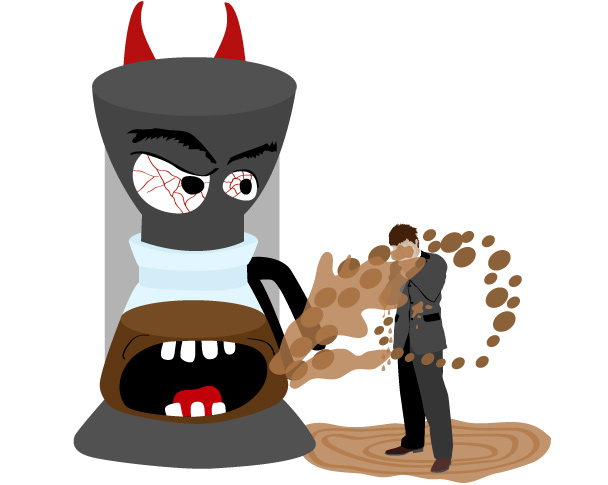Is your coffeemaker a drip? Does poor design short-circuit the satisfaction of your morning java? Read on for some classic coffeemaker shortcomings and how to get the right results when upgrading your caffeine machine.
Russell Flinchum: My goal was a simple one: to have a cup of hot, freshly ground and brewed coffee awaiting me at a regular hour in the morning. I did what I felt was a thorough investigation before ordering my Cuisinart Grind & Brew with the thermal carafe. But my experience has taught me a few lessons.
The first is not to be cheap. I chose the less-expensive grinder with the whirring blades that approximate the sound of an air-raid siren once the coffee is ground.
I also learned to make sure locking mechanisms actually lock. The basket that holds the filter on my machine is mounted on a spring-loaded bracket. If the catch is not firmly in place, one in eight times the basket will partially eject, covering the counter with hot, partially brewed coffee and grounds.
Alexandra Lange: My goal was even simpler: I bought my coffeemaker, a Rowenta designed by British minimalist Jasper Morrison, based solely on looks. It was white, it was dead simple—just one button!—and it went with my newly remodeled kitchen.
RF: If I saw a coffeemaker with a single button, my question would be, how much do I have to do before I get to press that single button?
AL: What you give up is an automatic timer. And it isn’t the one button that is the problem. It is things like no water indicator on the outside of the machine. That was fine when I had a glass carafe, but it broke (as they always do), and I could only get a thermal replacement, which has no water-level markings. Now, to see if I have poured the right amount of water into the coffeemaker, I have to stand on my tippy toes and peer into the depths of the machine, which is difficult if you are short (like me) and park your machine at the back of the counter (like most people do).
Also, the plastic on the lid and handle of the carafe is gray, which I assumed they chose because white would stain. But even the gray stains! And I always tangle with the superminimal lid. You’re supposed to be able to turn it with one thumb so that you can pour a cup of coffee single-handed. But it takes a giant’s thumb, so I always have to find a place to set the carafe down so that I can open the lid with two hands—while not burning my countertop. If I turn it too far, the lid falls off, spilling coffee everywhere.
Which is why we went to survey the marketplace at a typical home superstore, hoping to find something better out there. We evaluated the ergonomics; unfortunately, retailers don’t let you test the most important thing—taste.
RF: It’s clear to me that this is not a “one size fits all” proposition. All the coffeemakers we looked at—12-cup automatic-drip machines—revealed that an industrial designer had been involved, but none seemed to have functionality as their priority. My guess is that most coffeemakers are purchased in a big-box store setting, where the machines have to function as their own salesperson. Which means they have to get by on looks and “affordances,” as they were once called.
All the models were ridiculously tall when the lid on top was opened; an average of 22 inches, which is a full 4 inches greater than the standard distance between counters and upper cabinets. Several of the more appealing models had a small footprint but could only be used by turning the coffeemaker sideways, meaning you would need double the footprint to access the coffee basket.
AL: Pulling out the machine every morning would really bother me. What I like about mine is that it just sits there quietly on the counter, ready and waiting. All the machines now are so boss, for lack of a better word: rounded and bulging and black.
My favorite on looks alone was the Krups KM4065. It was the shortest and among the slimmest, but most important, it uses gray rather than black plastic with the stainless steel, which makes the whole thing recede visually. It has nice big buttons angled upward toward the user. But still, the thermal version had no outside water-level indicator, it was too tall with the lid up, and the coffee basket was really hard to remove for cleaning.



 Pinterest
Pinterest


